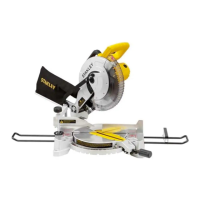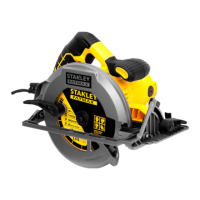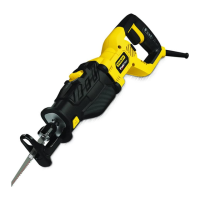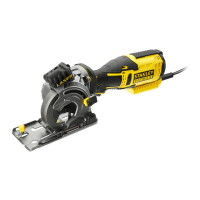12
2. Insert the parallel fence (w) into the base plate(h) as
shown in Figure J.
3. Tighten the parallel fence adjustment knob (x).
ADJUSTING
1. Slacken the fence adjustment knob (x) and set the
parallel fence (w) to the desired width. The adjustment can
be read on the parallel fence scale.
2. Tighten the fence adjustment knob (x).
Prior to Operation
♦
Make sure the guards have been mounted correctly. The
saw blade guard must be in closed position.
♦ Make sure the saw blade rotates in the direction of the
arrow on the blade.
♦ Do not use excessively worn saw blades.
OPERATION
Instructions for Use
WARNING: Always observe the safety instructions
and applicable regulations.
WARNING: To reduce the risk of injury, turn
unit off and disconnect machine from power
source before installing and removing
accessories, before adjusting or changing set-ups or
when making repairs. An accidental start-up can cause
injury.
Proper Hand Position (FIG. K)
WARNING: To reduce the risk of serious personal
injury, ALWAYS use proper hand position as
shown.
WARNING: To reduce the risk of serious personal
injury, ALWAYS hold securely in anticipation of a
sudden reaction.
Proper hand position requires one hand on the main handle
(b), with the other hand on the auxiliary handle (e).
Switching On and Off (FIG. A)
To run the tool, press the ON/OFF-switch (a).
To stop the tool, release the ON/OFF-switch. Always switch
OFF the tool when work is finished and before unplugging.
Switching On and Off (safety switch)(FIG. A)
If your saw is equipped with a safety switch to prevent
inadvertent operation, please follow the below instruction.
To run the tool, press the lock-off button (m) and subsequently
press the ON/OFF-switch (a). Release the lock-off button (m).
To stop the tool, release the ON/OFF-switch (a). Always
switch OFF the tool when work is finished and before
unplugging.
NOTICE: Do not switch the tool ON or OFF when the saw
blade touches the workpiece or other materials.
Workpiece Support (FIG. L–P)
WARNING: To reduce the risk of serious
personal injury, support the work properly
and hold the saw firmly to prevent loss of
control.
Figures M and O show proper sawing position. Figures N
and P show an unsafe condition. Hands should be kept
away from cutting area, and power cord is positioned clear
of the cutting area so that it will not get caught or hung up
on the work.
To avoid kickback, ALWAYS support board or panel NEAR
the cut, (Fig. M and O). DON’T support board or panel away
from the cut (Fig. N and P).
When operating the saw, keep the cord away from the cutting
area and prevent it from becoming hung up on the work piece.
ALWAYS DISCONNECT SAW BEFORE MAKING ANY
ADJUST MENTS! Place the work with its “good” side—the
one on which appearance is most important—down. The
saw cuts upward, so any splintering will be on the work face
that is up when you saw it.
Cutting
WARNING: Never attempt to use this tool by
resting it upside down on a work surface and
bringing the material to the tool. Always securely
clamp the workpiece and bring the tool to the workpiece,
securely holding the tool with two hands as shown in Figure
P.
Place the wider portion of the saw foot plate on that part of
the work piece which is solidly supported, not on the section
that will fall off when the cut is made. As examples, Figure
P illustrates the RIGHT way to cut off the end of a board.
Always clamp work. Don’t try to hold short pieces by hand!
Remember to support cantilevered and overhanging material.
Use caution when sawing material from below.
Be sure saw is up to full speed before blade contacts material
to be cut. Starting saw with blade against material to be cut
or pushed forward into kerf can result in kickback. Push the
saw forward at a speed which allows the blade to cut without
laboring. Hardness and toughness can vary even in the same
piece of material, and knotty or damp sections can put a
heavy load on the saw. When this happens, push the saw
more slowly, but hard enough to keep working without much
decrease in speed. Forcing the saw can cause rough cuts,
inaccuracy, kickback, and over-heating of the motor. Should
your cut begin to go off the line, don’t try to force it back on.
Release the switch and allow blade to come to a complete
stop. Then you can withdraw the saw, sight anew, and start a
new cut slightly inside the wrong one. In any event, withdraw
the saw if you must shift the cut. Forcing a correction inside
the cut can stall the saw and lead to kickback.
IF SAW STALLS, RELEASE THE TRIGGER AND BACK
THE SAW UNTIL IT IS LOOSE. BE SURE BLADE IS
STRAIGHT IN THE CUT AND CLEAR OF THE CUTTING
EDGE BEFORE RESTARTING.
As you finish a cut, release the trigger and allow the blade to
stop before lifting the saw from the work. As you lift the saw,
the spring-tensioned telescoping guard will automatically
close under the blade. Remember the blade is exposed
until this occurs.
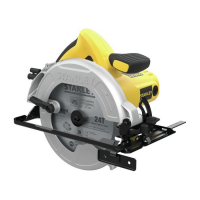
